Acoustic System Resonators
|
My Cherie Amour, (pretty little one that I adore) |
|
Clement Perry |
|
November 2004 |

Nearly five years ago Stereo Times introduced Mike Van Evers’ four-part article, “The Art and Science of Audio System Tuning,” to our readers. This instructive study of acoustics and the taming of room resonance modes proved to be one of our most read articles. (It is still highly recommended reading, located in our archives). VansEvers went to great lengths detailing the good, bad and the often-misunderstood effects of resonances. Here’s one of the more memorable passages that comes to mind (from Part 2):
“The ‘Resonance Response’ of an audio system is always a major factor in its musicality. The most musically neutral systems will have their resonance’s spread out evenly with no clumps or gaps in their distribution…just as the best listening rooms have an even distribution of standing waves. An even distribution of resonance’s establishes a level playing field for all of music’s notes and overtones, allows the proper harmonic balance of the music to be preserved, and maximizes listening enjoyment.”
Funny thing, I not only believed wholeheartedly in Van Evers approach, but experimented myself by taking some of the tests he suggested. I wanted to see if I too could detect a change in resonances by placing CD jewel cases atop my CD player, amplifiers and preamp. I could not. Thus my conclusion this type tweak was located on the fringe. I wondered aloud if I was simply unable to hear a difference or was my skepticism getting the best of me? Don’t get me wrong. I believed in the science behind Vans Evers’ comments, that resonances could negatively effect a potentially good sounding setup. I knew this because I was a very early adopter of the Tact 2.2 Room Correction preamplifier and I knew that with proper measurement and adjustment in the digital realm, a lot of improvement was possible. However, using the techniques Van Evers spoke of―coupling and decoupling devices, shiny objects along with different types of wood, and so forth―well, I just wasn’t convinced that these approaches would work.
I want my system to sound great as much as the next guy, but I’m not willing to go to any lengths to make that happen. Checking the directionality of all my wires, grounding my AC in a star-configuration, checking the type of walls that comprise my listening room, concrete, wood, sheetrock and their resonant characteristics, was in my book going a bit too far.
Few audiophiles believe in enhancing harmonic overtones by strategically placing objects in a listening room. But consider my situation, employing room correction as necessary to create a sonically balanced acoustic space. The Argent Room Lens plays a very important role by removing unwanted resonances that the Tact 2.2 can only partially control. Yes, I’d read about Mpingo discs from Shun Mook and Harmonix room tuning devices, but I always considered such products on the fringe of audiophila, a hobby already in dangerously close proximity to your local nut farm.
No disrespect to Vans Evers; he does what he does, and I’d be the first to admit he knows his stuff. But I wanted an easier, softer, more conventional way. Tact room correction, along with Ric Cummins’ Argent Room Lens, provided just that. As a matter of fact, here it is five years later and counting, both products remain in my system, and no white coats have come to get me.
Fast forward to the CES 2004.
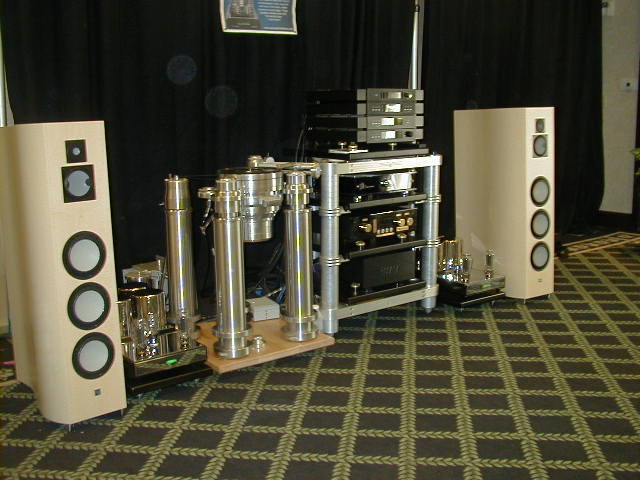 Walking the 2004 CES with Dave Thomas, Mike Wright, Key Kim and Delve Audio’s Oliver Solomon, we were approached by Bruce Featherling of Acoustic Dreams. He was very excited. Now, if you know Bruce and his brother Scott, then you know that very few things excite these two—unless it’s serious business. Acoustic Dreams, a Featherling-owned business, imports such high-endproducts such as dCS, Ayon and the Lumen White, just to name a few. So we were intrigued by all this excitement about a mysterious tweak that the Featherlings swore “should change the way you think of tweaks.” “Yeah, I’ve heard that before,” I mumbled under my breath. We were led into the Acoustic Dreams room, which was featured at T.H.E Show, and once we got inside and saw what they were talking about, we thought it was a joke. Bruce Featherling showed me these small metal cups that resembled gladiator helmets for Barbie dolls. Now, get this: the Featherlings told us that by just moving these “helmets” around on the top of each loudspeaker cabinet, the sound changed dramatically. I was taken aback by their enthusiasm and was hesitant to join in because, quite honestly, I thought someone had been passing around too much complimentary wine. I suspected the Featherlings had lost, well, a few of their feathers.
Walking the 2004 CES with Dave Thomas, Mike Wright, Key Kim and Delve Audio’s Oliver Solomon, we were approached by Bruce Featherling of Acoustic Dreams. He was very excited. Now, if you know Bruce and his brother Scott, then you know that very few things excite these two—unless it’s serious business. Acoustic Dreams, a Featherling-owned business, imports such high-endproducts such as dCS, Ayon and the Lumen White, just to name a few. So we were intrigued by all this excitement about a mysterious tweak that the Featherlings swore “should change the way you think of tweaks.” “Yeah, I’ve heard that before,” I mumbled under my breath. We were led into the Acoustic Dreams room, which was featured at T.H.E Show, and once we got inside and saw what they were talking about, we thought it was a joke. Bruce Featherling showed me these small metal cups that resembled gladiator helmets for Barbie dolls. Now, get this: the Featherlings told us that by just moving these “helmets” around on the top of each loudspeaker cabinet, the sound changed dramatically. I was taken aback by their enthusiasm and was hesitant to join in because, quite honestly, I thought someone had been passing around too much complimentary wine. I suspected the Featherlings had lost, well, a few of their feathers.
This didn’t dissuade the group of us from accepting their invitation for a demonstration. Hey, I know these guys are serious lovers of music, first and foremost (we’ve had long, long listening sessions together whenever they come to New Jersey for a visit). After a couple of A/B’s, and swapping of seats, Oliver Solomon was the first of our group to pick out sonic differences. I could not. Oliver commented, “the harmonics somehow improved.” I looked at him like he needed a breathalyzer test. Then it dawned on me that Oliver, like me, doesn’t indulge in alcoholic beverages. But then Key Kim, Dave Thomas and Mike Wright thought perhaps they too heard a difference, however small. All of these guys concluded that something in the sound improved. Bemused, I wondered why I couldn’t hear a difference while everyone else swore they could? I decided to get more serious and to really concentrate on what I was hearing. I still could not hear a difference in terms of harmonics. But I did ask if someone was playing with the volume control: it sounded as if someone was ever so slightly turning up the loudness.
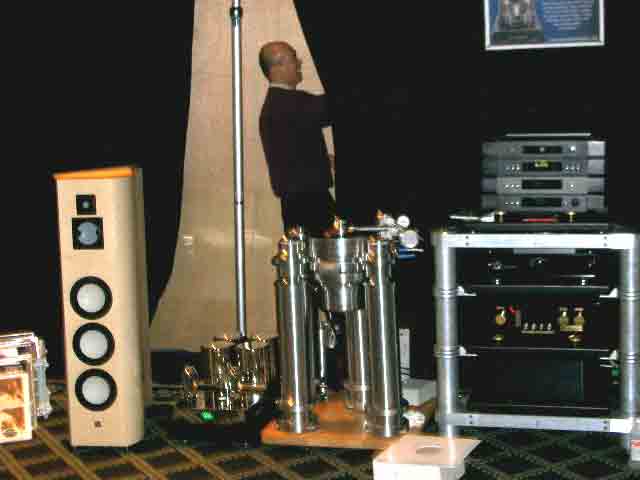
It was at this moment the man from Acoustic Resonators, Frank Tchang, (photo right: the wizard behind the curtain)an acoustic alchemist himself, walked into the room, all quiet and composed. He smiled graciously, took a personal inventory of all the new faces in the room, and then began to tell quite a fascinating story. It was about the design of the Acoustic Resonator, with emphasis on his goal of improving harmonics and overtones while at the same time canceling unwanted resonances.
Meanwhile, Back at the Ranch.
Frank Tchang suggested I experiment with Acoustic Resonators in a more familiar venue, and in due time a package arrived at my humble abode. The Featherlings sent me two Basic and one Silver Resonator. I installed them in a similar configuration to that I remembered from the Acoustic Dreams room: the two Basic resonators were placed right on the front wall directly behind my Ascendo loudspeakers, while the Silver went dead-center at eye level. I could detect only small changes in the level of treble energy. In the end, I concluded they “worked,” however subtly, but they certainly weren’t doing enough to justify the asking price. And for what they ask for a Basic is a whopping $200.00. And that’s just for starters. Silver costs $350.00 each. A Gold resonator will set you back $900.00 A Platinum $1800.00! I know, I know any one paying those prices must have escaped the nut farm
I was packing them up and preparing to return them with a thanks but no-thanks note attached…
Then the door bell rang.
The U.S. mailman handed me a medium-sized box with a bunch of Charles De Gaulle stamps on it. I wondered what on earth this could be? Well, it seems Franck Tchang hadn’t quite sent me all the necessary weapons in his acoustic arsenal. For in this care package were the Gold, Special Gold and Platinum Resonators along with another pair of Silver and Basic thrown in just for good measure. Probably just as important was an installation guide. Browsing through the guide I discovered just how poorly the first three resonators had been set up. For example, only Gold or Platinum are recommended for placement between the loudspeakers, and I’d had the Silver centered there.
With a complete arsenal at hand, the first thing I did was make a fresh pot of coffee. And then checked my humidor for any remaining Siglo VI Cohibas I had purchased in Switzerland on a stop-over flight returning from the Munich show. (Coincidentally, Acoustic Resonators was a huge success at that show). I suspected this was going to be a special evening, and my usual preparation on such occasions is java in one hand and stogie in the other. I had done some research and spoken with Franck Tchang earlier that day and he assured me that I was in for a treat, if I followed the setup procedure correctly.
Before I share my experience of that evening, let me first tell you what I’ve since learned about Acoustic Resonators. Tchang designs five types of resonators that come standard with maple-wood pedestals accented with two beads. These small blocks of wood are well-seasoned and carefully chosen for their specific application.
![]() Basic is an alloy of copper and silver and is designed for low-frequency room resonance. It weighs 4.5 grams and Tchang says it produces a “straight and fast” resonance. Its base is soft instrument maple.
Basic is an alloy of copper and silver and is designed for low-frequency room resonance. It weighs 4.5 grams and Tchang says it produces a “straight and fast” resonance. Its base is soft instrument maple. ![]() Silver is the second in the lineup and weighs 5 grams. It is an alloy of two-parts silver to one-part copper. According to Tchang this creates a sound “light, open and airy” in character, intended to open up soundstage width. It uses the same soft instrument maple for its base.
Silver is the second in the lineup and weighs 5 grams. It is an alloy of two-parts silver to one-part copper. According to Tchang this creates a sound “light, open and airy” in character, intended to open up soundstage width. It uses the same soft instrument maple for its base. ![]() Gold uses an alloy of 18-carat gold, silver and copper. It weighs 7 grams and possesses a sonic character that is “rich with a slight compression.” It was specifically designed for big, bright rooms with low ceilings, that have lots of damping material such as sofas and drapes. A hard instrument maple base comes standard with Gold.
Gold uses an alloy of 18-carat gold, silver and copper. It weighs 7 grams and possesses a sonic character that is “rich with a slight compression.” It was specifically designed for big, bright rooms with low ceilings, that have lots of damping material such as sofas and drapes. A hard instrument maple base comes standard with Gold.![]() Special Gold employs 14-carat gold, producing a sound that’s “rich, brilliant with no compression” says Tchang. It weighs 6.5 grams and is for a low-ceiling basement setup, though any type of room will benefit due to its no compression characteristic.
Special Gold employs 14-carat gold, producing a sound that’s “rich, brilliant with no compression” says Tchang. It weighs 6.5 grams and is for a low-ceiling basement setup, though any type of room will benefit due to its no compression characteristic.![]()
Platinum is the most expensive resonator Tchang makes and for a good reason: it is made of 98% pure Platinum, weighs 9 grams, and produces the most improvement of any of his resonators. The Platinum, says Tchang “possesses a wide-open sound with no compression or compromise.” Both the Gold, Special Gold and Platinum use a hard instrument maple base.
That evening.
My seat position is on the long wall of my living room. It measures about 21 feet in length. Following the installation guide I placed a single Special Gold dead center at listening height on the front wall between the loudspeakers. A Platinum went about 18” above this. In the corners, close to the sidewalls and about 6” from the 7’ 8” ceiling, I placed a Silver. Below the Silver at about ear level, I placed a Gold. This completed the front wall. A Basic went on the rear edges of the back wall, close to the corners, while I placed the remaining Silver on the wall right behind my head (about 3’ away from my listening seat).
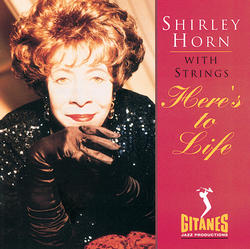 The CD that has recently been getting the most play and sending shivers down many a spine is Shirley Horn with Strings—Here’s to Life(Verve 314511879-2). Johnny Mandel, who worked as composer and arranger on this album, was a long awaited dream for Horn. Backing Horn was a 49-piece ensemble of hand-picked musicians including 18 violins, 6 violas, 6 cellos and 4 basses, while brass and woodwinds attacked during Horn’s soaring climax in Here’s To Life. This is an amazing recording with superb musicians showcasing Horn’s incredible repertoire. Carefully selected accompaniment is one reason she is so often compared to the three greatest jazz singers of all time: Ella, Sarah and Billie. This CD was recorded in 1992, over 12-years ago, but the sound quality is extraordinary!
The CD that has recently been getting the most play and sending shivers down many a spine is Shirley Horn with Strings—Here’s to Life(Verve 314511879-2). Johnny Mandel, who worked as composer and arranger on this album, was a long awaited dream for Horn. Backing Horn was a 49-piece ensemble of hand-picked musicians including 18 violins, 6 violas, 6 cellos and 4 basses, while brass and woodwinds attacked during Horn’s soaring climax in Here’s To Life. This is an amazing recording with superb musicians showcasing Horn’s incredible repertoire. Carefully selected accompaniment is one reason she is so often compared to the three greatest jazz singers of all time: Ella, Sarah and Billie. This CD was recorded in 1992, over 12-years ago, but the sound quality is extraordinary!
Listening to this wonderfully rich and textured CD was never more splendid than when heard with the Acoustic Resonators. For example, on Where Do You Start, Horn’s voice became immediately more resonant, adding a three-dimensionality and more life-like weight to her voice― acoustic qualities that are generally associated with vacuum tube electronics. My system, as you may know, is an all-digital setup that is one of the most accurate I believe available–by sheer virtue of the electronics chosen. Digital electronics can sound delightfully appealing because of its clean, see-through clarity, and an incredibly tight and well-damped bass that allows one to hear into the rhythmic quality of a musical performance.
I found it difficult to believe the degree of change these mere metal “helmets” produced and, as a result, experimentally removed all of them, just to rule out the possibility I was imaging things. Shirley’s sultry voice suddenly thinned out, sounding almost anorexic in comparison, and it displayed far less harmonic color, overtones and shadings. She appeared smaller and further back in the soundstage. The leading edges of the strings rolled off much faster, and the woodwinds seemed to lose their breadth.
One of most significant aspects of this evaluation is how readily my findings can be repeated. Simply removing the resonators from the wall—and putting them back—is all it takes to do a thorough A/B test. No turning components off and on, no switching cables, and so forth. Stick them on the wall and take them off. It’s that simple. Tchang was right about trying them out in my home and on my own terms. It also helps that I am quite familiar with all the electronics as well as the acoustics of my room. I was left with no doubt that Acoustic Resonators not only work, but work better than I would have never believed possible.
Moreover, I have never regarded my stereo’s sound as thin or lacking in richness. Yet, after auditioning the Acoustic Resonators, I could only describe the “before” sound as just that—and therefore ultimately lacking musicality. Franck Tchang and the Featherling brothers are convinced that no matter the price or sophistication of the system, whether tube, solid-state analog or digital, the results are the same: with Acoustic Resonators installed the sound is richer and more resonant.
Next Stop…Paris
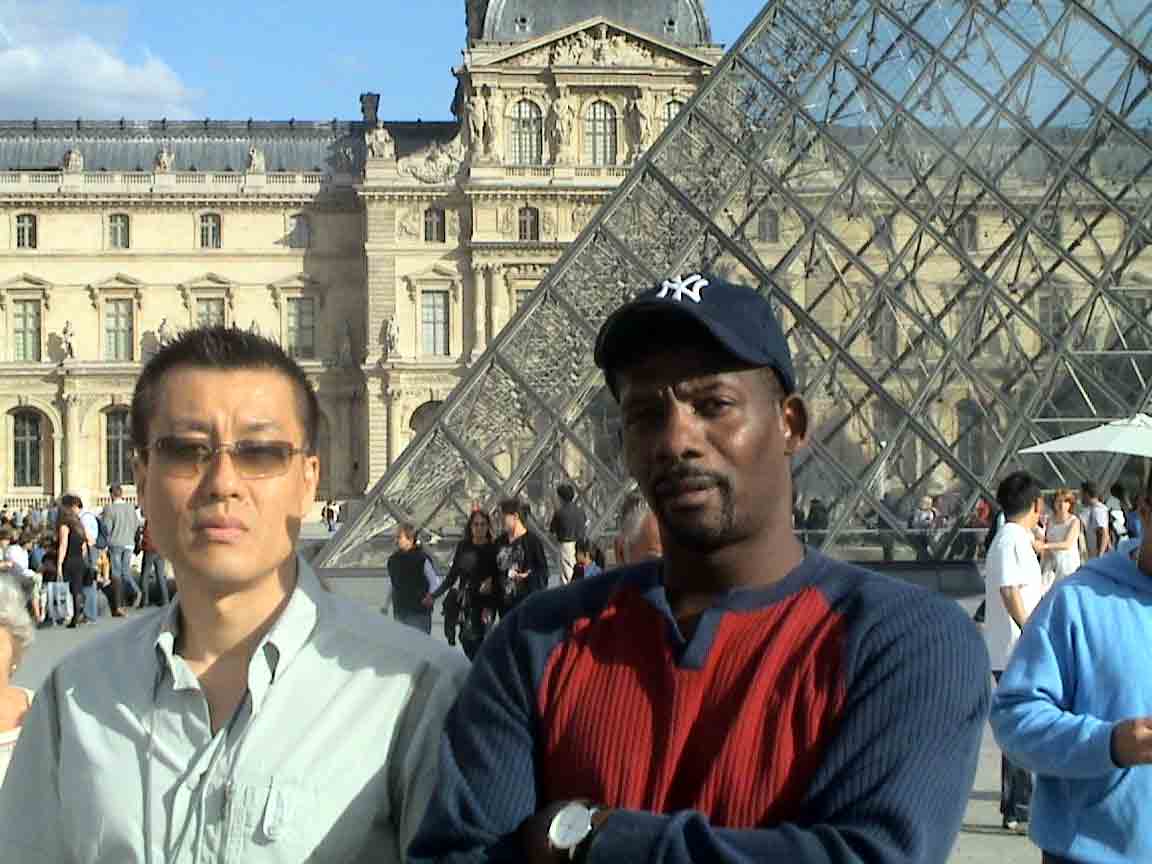

Finally, I wanted to know more about Acoustic Resonators as a company and about the man, Franck Tchang. So it was off to Paris, the City of Lights. After spending three or four days sightseeing, visiting fabulous sights such as the Louvre museum (above) and browsing the shopping districts with my wife, Key Kim joined in on the escapades (unfortunately, Key’s wife had a family emergency and had to cancel her flight at the last minute).
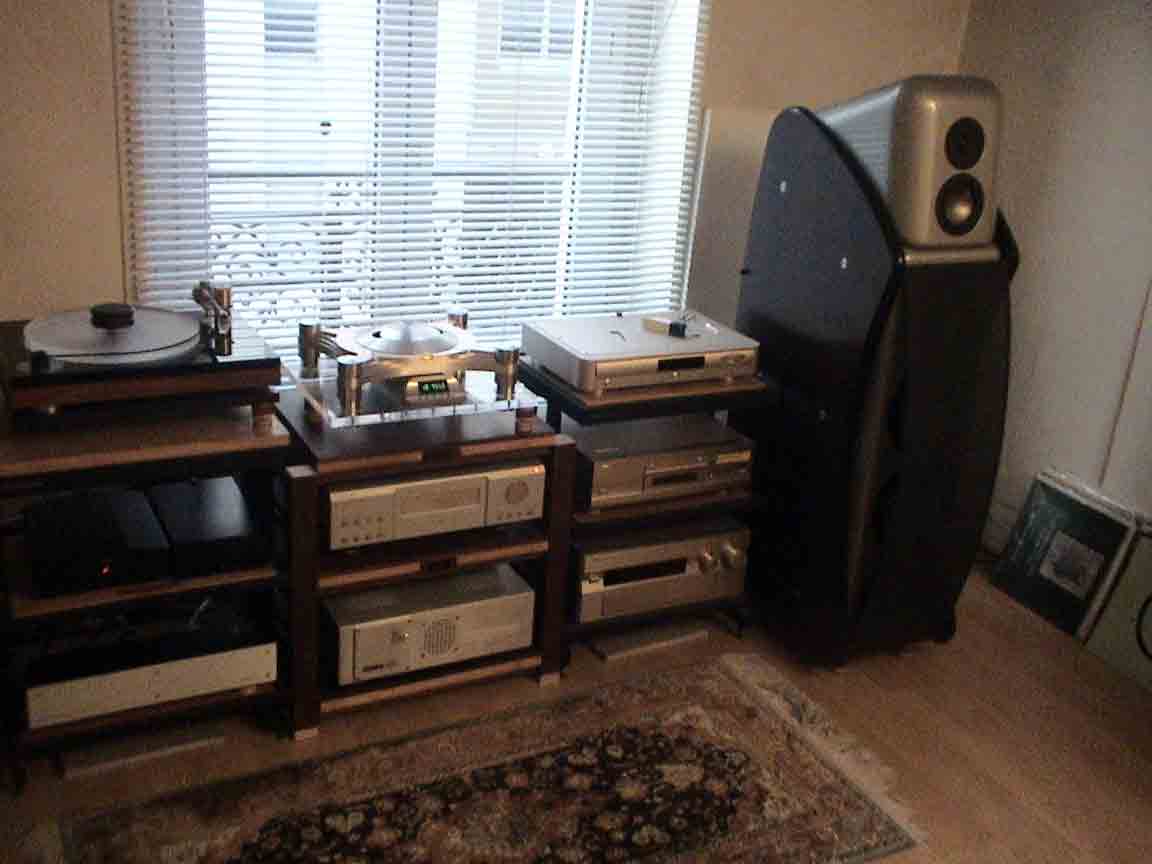
We finally got the chance to visit the home of Franck Tchang. He owns quite an elaborate audiophile setup, in spite of a small listening room. (One of the first things you notice about Paris is how small most of the apartments are. Of course, our hotel room was no exception.) Nonetheless, I was astonished at how vast a soundstage Tchang’s system threw over a relatively short front wall. In addition, the sound had all the unmistakable qualities I had grown accustomed to while auditioning his Acoustic Resonators. The sheer musicality was breathtaking. Key and I talked long into the night about what measures Tchang must have taken to create such a huge soundstage in so small a space.
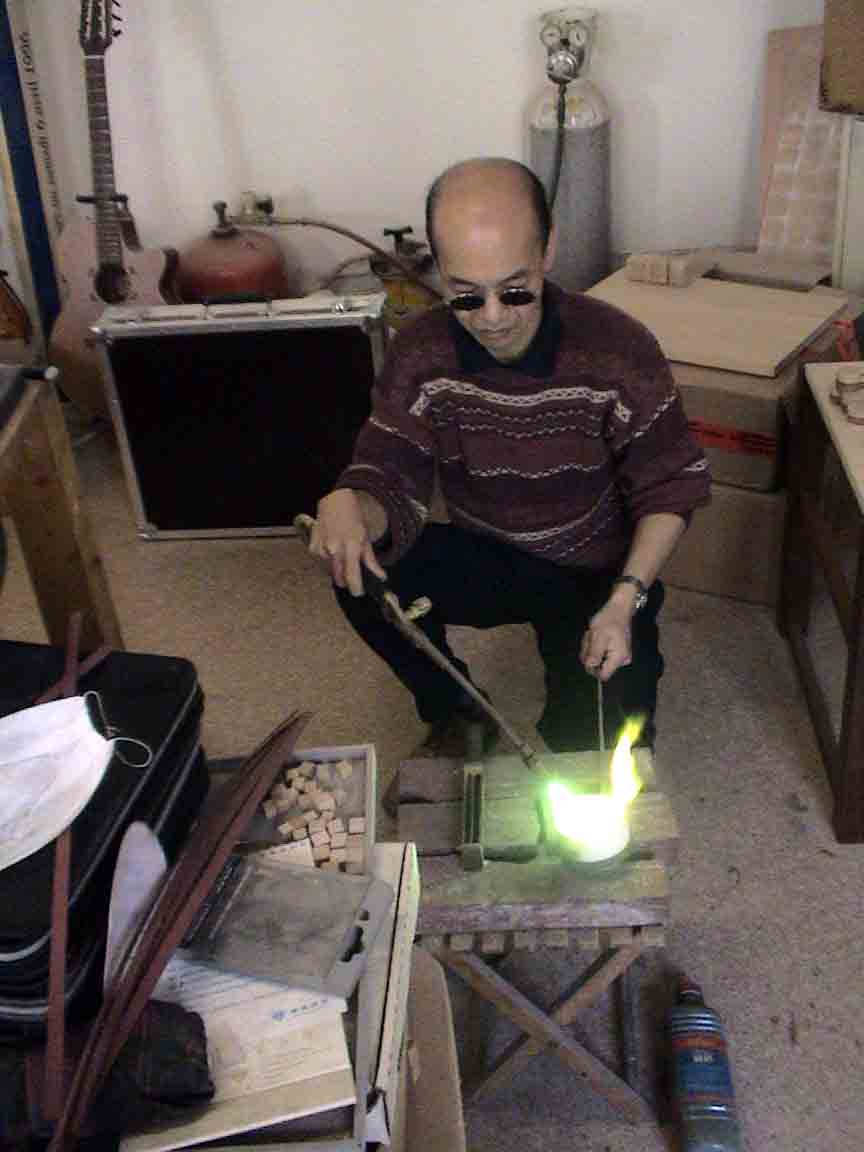
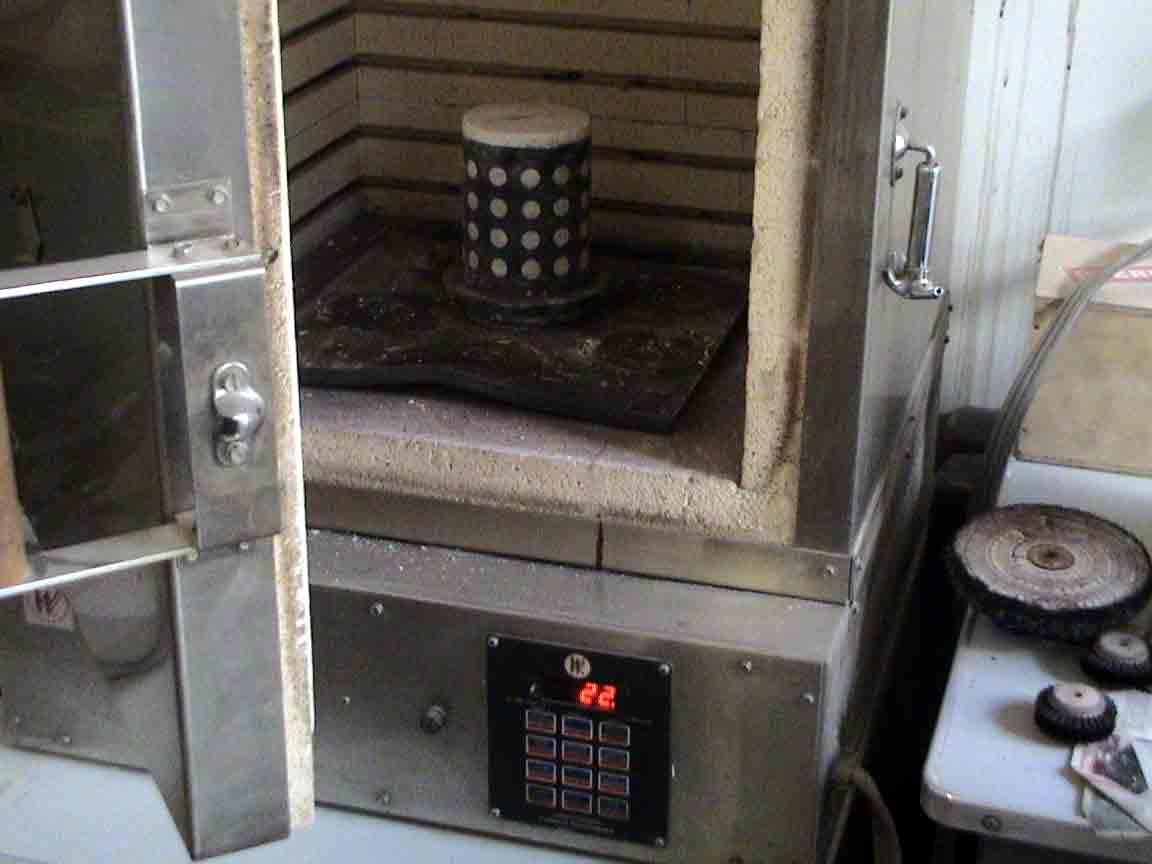
The next day we visited Tchang’s factory (above) and witnessed how heheats and mixes precious metals to manufacture the finished products.
Tchang has a system in his office that is quite ordinary in every way― except for the sound! 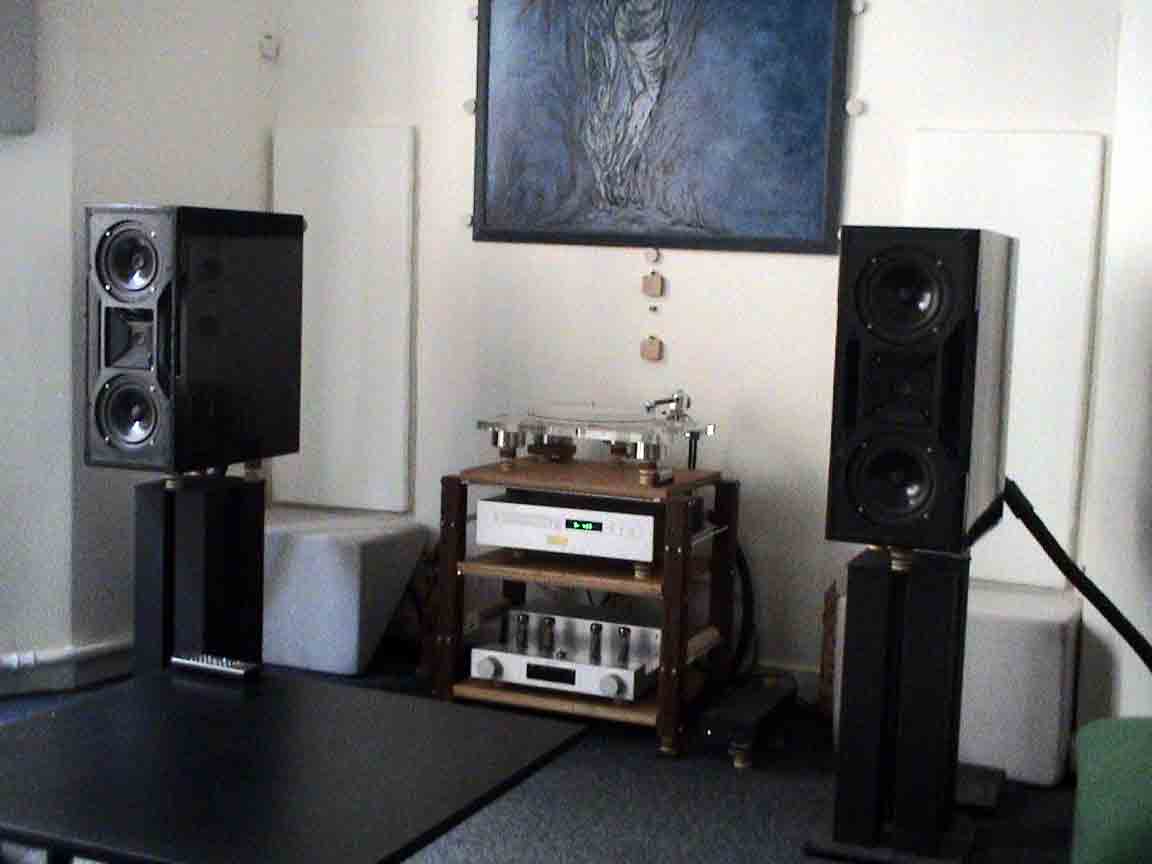 This system uses Wilson Audio Cubs, some puny integrated amplifier and a CD player by a company called Octave. Both Key and I heard a soundstage that literally went out of the window, located left of my seat, and out into the hallway, located to my right. Tchang played with the resonators while we were listening. Changes to the depth and width of the soundstage were obvious. It occurred to me that Franck Tchang knew more about room acoustics and techniques for taming them than anyone I had ever met. Our conversations went on far into the night during the next couple of days. The one thing you learn after spending that amount of time with Frank Tchang is this: his love and knowledge of music, both from a musician’s standpoint (he plays a wicked guitar) and as an audiophile, is extraordinary. His no-nonsense approach to dealing with acoustical problems is legendary, especially in Germany where his products are gaining wide acceptance.
This system uses Wilson Audio Cubs, some puny integrated amplifier and a CD player by a company called Octave. Both Key and I heard a soundstage that literally went out of the window, located left of my seat, and out into the hallway, located to my right. Tchang played with the resonators while we were listening. Changes to the depth and width of the soundstage were obvious. It occurred to me that Franck Tchang knew more about room acoustics and techniques for taming them than anyone I had ever met. Our conversations went on far into the night during the next couple of days. The one thing you learn after spending that amount of time with Frank Tchang is this: his love and knowledge of music, both from a musician’s standpoint (he plays a wicked guitar) and as an audiophile, is extraordinary. His no-nonsense approach to dealing with acoustical problems is legendary, especially in Germany where his products are gaining wide acceptance.
My cherie amour, pretty little one that I adore.
You’re the only girl my heart beats for.
How I wish that you were mine….
La la la la la la, La la la la la la
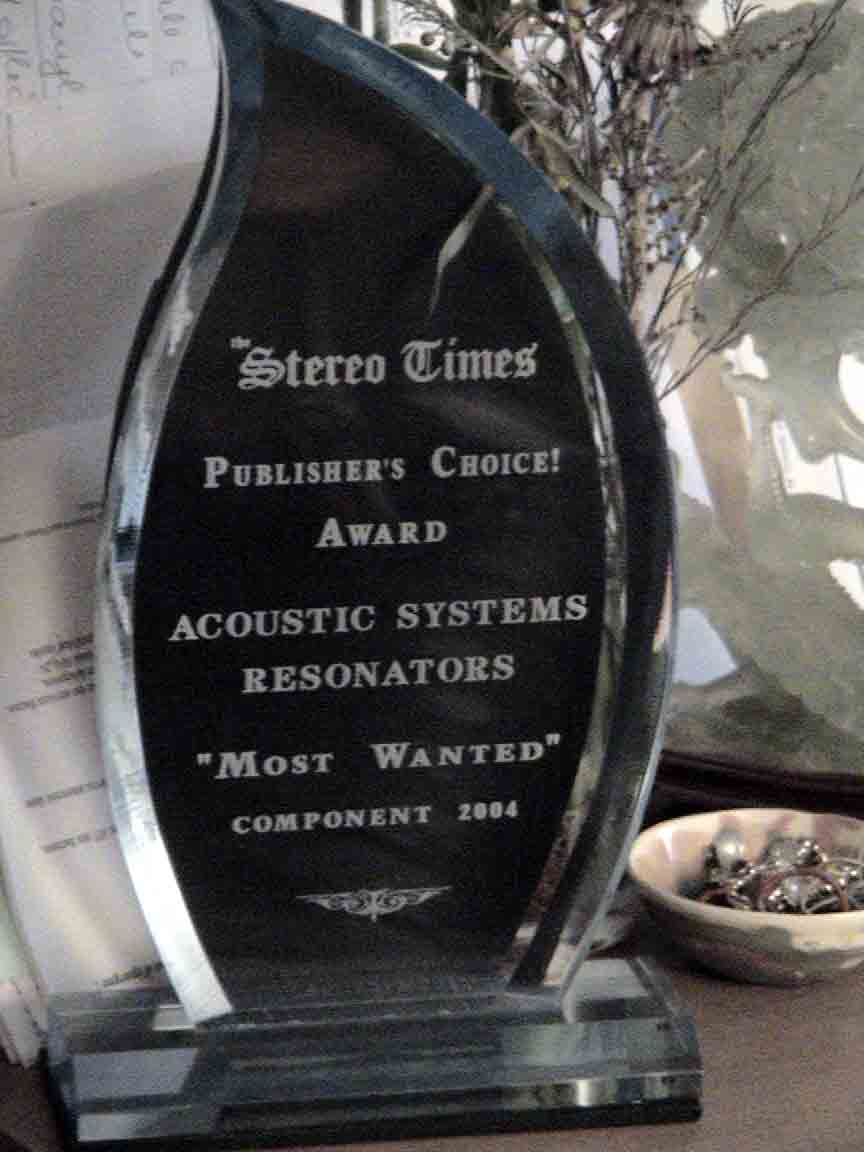 Barring the Acoustic Resonator’s exorbitant price, my experience with the them has served as a rude-awakening. Personally, I find their improvements, when Platinum, Gold and Silver is used, on par with that of an component–which somewhat justifies their cost. Therefore, I suggest strongly, that you give a set an audition especially if you’ve ideas of upgrading your system. for that ailing system. They’ve literally changed what I’ve come to expect from a music playback system, and I am grateful for the experience. My thoughts about using products such as these, at the risk of being considered on the lunatic fringe, has changed, and many others here and in Europe have joined me. And if I have flipped my wig, then I wish I had done it sooner, considering the outcome. Highly recommended!
Barring the Acoustic Resonator’s exorbitant price, my experience with the them has served as a rude-awakening. Personally, I find their improvements, when Platinum, Gold and Silver is used, on par with that of an component–which somewhat justifies their cost. Therefore, I suggest strongly, that you give a set an audition especially if you’ve ideas of upgrading your system. for that ailing system. They’ve literally changed what I’ve come to expect from a music playback system, and I am grateful for the experience. My thoughts about using products such as these, at the risk of being considered on the lunatic fringe, has changed, and many others here and in Europe have joined me. And if I have flipped my wig, then I wish I had done it sooner, considering the outcome. Highly recommended!
Acoustic Resonator is a proud recipient of Stereo Times’ Publisher’s Choice Most Wanted Component 2004 Award!
___________________
Prices:
Basic: $200.00
Silver: $350.00
Gold: $900.00
Special Gold: $900.00
Platinum: $1800.00
Contact:
Acoustic Dreams
RR #5 Box 429
Fairfield, IL 62837 USA
Telephone: 618 . 847 . 7813
Facsimile: 618 . 847 . 4809
www.acousticdreams.net
audiosales@acousticdreams.net
![]()
Don’t forget to bookmark us! (CTRL-SHFT-D)
Stereo Times Masthead
Publisher/Founder
Clement Perry
Editor
Dave Thomas
Senior Editors
Frank Alles, Mike Girardi, Key Kim, Russell Lichter, Terry London, Moreno Mitchell, Paul Szabady, Bill Wells, Mike Wright, Stephen Yan, and Rob Dockery
Current Contributors
David Abramson, Tim Barrall, Dave Allison, Ron Cook, Lewis Dardick, Dan Secula, Don Shaulis, Greg Simmons, Eric Teh, Greg Voth, Richard Willie, Ed Van Winkle, and Rob Dockery
Music Reviewers:
Carlos Sanchez, John Jonczyk, John Sprung and Russell Lichter
Site Management Clement Perry
Ad Designer: Martin Perry





Be the first to comment on: Acoustic System Resonators